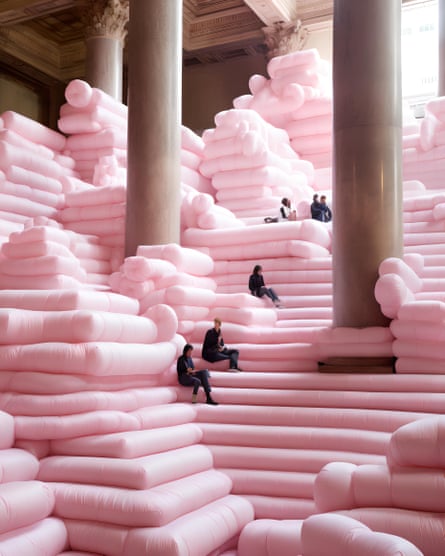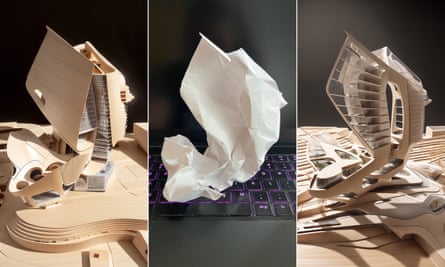
[ad_1]
A handful of little inexperienced blocks flashes up at the display, filling a construction web site with a neat grid of uniform cubes. One 2nd they shape rows of towers, subsequent they morph into low-rise courtyards, then they turn again into lengthy narrow slabs, earlier than biking via masses of different iterations, in a hypnotic high-speed ballet of bristling structures.
I watch this whilst on a Zoom name with Wanyu He, an architect founded in Shenzhen, China, and the founding father of XKool, a synthetic intelligence corporate decided to revolutionise the structure business. She freezes the dancing blocks and zooms in, revealing a format of lodge rooms that fidget and reorder themselves because the construction swells and contracts. Corridors transfer aspects, furnishings dances from side to side. Every other click on and an invisible international of pipes and wires seems, a matrix of products and services bending and splicing in mesmerising unison, the site of lights, plug sockets and switches mechanically optimised. One additional click on and the development drawings pop up, in conjunction with a value breakdown and parts listing. All the plan is able to be despatched to the manufacturing unit to be constructed.
I applaud He on what appears to be an outstanding theoretical workout: a 500-room lodge complicated designed in mins with the assistance of AI. However she appears to be like perplexed. “Oh,” she says casually, “that’s already been constructed! It took 4 and a part months from begin to end.”

The guarantees – and perils – of AI had been gripping the sector of structure and design in contemporary months, however few have grasped that the revolution is already below means. Symbol-making equipment equivalent to Dall-E, Midjourney and Solid Diffusion have allowed the easy introduction of seductive visions: skyscrapers within the taste of Frank Lloyd Wright, fable mash-ups of sci-fi and artwork nouveau, squidgy marshmallow staircases, structures fabricated from garbage. It could be entertaining to visualize Gaudí designing kitchen devices or Le Corbusier embracing parametricism, however AI is already being deployed to form the genuine international – with far-reaching penalties.
“The issue with architects is that we nearly fully center of attention on photographs,” says Neil Leach, writer of Structure within the Age of Synthetic Intelligence. “However essentially the most progressive exchange is within the much less horny space: the automation of all of the design bundle, from creating preliminary choices throughout to building. With regards to strategic pondering and real-time research, AI is already means past what human architects are able to. This may well be the general nail within the coffin of a suffering occupation.”
In Leach’s view, XKool is on the bleeding fringe of architectural AI. And it’s rising rapid: over 50,000 persons are already the use of it in China, and an English model of its image-to-image AI software, LookX, has simply been introduced. Wanyu He based the corporate in 2016, with others who used to paintings for OMA, the structure follow of Rem Koolhaas (therefore the corporate names). They’d turn out to be disenchanted with what they noticed as an superseded means of running. “It wasn’t how I imagined the way forward for structure,” says He, who labored in OMA’s Rotterdam administrative center earlier than shifting to China to supervise building of the Shenzhen Inventory Alternate construction. “The design and building processes have been so conventional and missing in innovation.”
She and her colleagues have been impressed to release their startup after witnessing AlphaGo, the primary pc program to defeat a human champion on the Chinese language board sport Move in 2016. “What if lets introduce this intelligence to our means of running with algorithmic design?” she says. “CAD [computer aided design] dates from the 70s. BIM [building information modelling] is from the 90s. Now that we’ve got the ability of cloud computing and massive information, it’s time for one thing new.”
XKool objectives to offer an all-in-one platform, the use of AI to lend a hand with the entirety from producing masterplan layouts, the use of given parameters equivalent to sunlight necessities, house requirements and native making plans rules, proper all the way down to producing interiors and building main points. It has additionally evolved a device to turn out to be a 2D picture of a construction right into a three-D style, and switch a given listing of room sizes into flooring plans. It’s early days and, to this point, the consequences are clunky: the Shenzhen lodge appears to be like very a lot adore it was once designed by way of robots for a military of robotic visitors.

Some architects are calling for warning – no longer out of concern for his or her jobs, however as a result of what the tech may spawn, and the potential of information being misused. “We should be cautious,” says Martha Tsigkari, head of implemented analysis and building at Foster + Companions in London. “It may be bad when you don’t know what information was once used to coach the style, or when you haven’t categorized it correctly. Knowledge is the entirety: when you put rubbish in, you’ll get rubbish out. The consequences for information privateness and highbrow belongings are massive – is our information secured from different customers? Is it getting used to retrain those fashions within the background?”
Tsigkari and her workforce had been probing the probabilities of device studying for the closing 5 years, on their very own safe servers, the use of information from the in depth library of Foster tasks. One among their first experiments used AI to discover how thermally responsive laminate fabrics may well be utilized in facades, converting their form to answer temperature. “Relying at the layering of the laminate, that you must have a unique deformation below other warmth stipulations,” says Sherif Tarabishy, Foster + Companions’ design methods analyst. “Consider a facade that might passively deform, growing louvres or overhangs to colour other portions of a construction in line with the temperature.”

Even though the true science had to make such issues imaginable is some distance off, AI does allow the type of calculations and predictive modelling that was once impossibly time-consuming earlier than. Tsigkari’s workforce has additionally evolved a simulation engine that permits realtime research of flooring plans – appearing how smartly attached one a part of a construction is to every other – giving designers immediate comments at the implications of shifting a wall or piece of furnishings. Tarabishy presentations me a throbbing colour-coded diagram of an administrative center, filled with assembly rooms and desks: this climate map of swirling, pulsing colors adjustments because the AI jiggles the rooms into the optimal association. It’s spectacular, but it surely additionally suggests a type of uber-Taylorism, the entirety calibrated for final potency. May the overuse of AI squeeze out the pleasure of dawdling, the charms of the leftover and unplanned?
Whilst few companies can boast an in-house R&D lab like Foster’s, architects around the spectrum are adopting AI equipment in several tactics. One informed me they now frequently use ChatGPT to summarise native making plans insurance policies and examine the efficiency of various fabrics for, say, insulation. “It’s the type of activity you could have given a junior to do,” they are saying. “It’s no longer best possible, but it surely makes fewer errors than any person who hasn’t written a specification earlier than.”
Others say their groups frequently use Midjourney to lend a hand brainstorm concepts all over the concept that segment. “We had a consumer short of to construct mosques in Abu Dhabi,” one architect informed me. “I may temporarily generate a variety of choices to turn them, to get the dialog going. It’s like an immediate temper board.”

The past due Zaha Hadid’s company, ZHA, headed by way of techno-evangelist Patrik Schumacher, has embraced AI for early “ideation”, the use of Midjourney to churn out choices in its unique dwelling taste. “You don’t even need to do a lot,” Schumacher stated in a up to date on-line dialogue, as photographs of swooping paperwork flashed directly to the display, like globs of chewing gum stretched into oblivion. “You display them uncooked and you’ll be able to generate concepts with purchasers. The sunshine, shadow, geometry, coherency, sense of gravity and order is so potent.” It’s no wonder that the company’s heady visions for a barren region spa hotel complicated in Neom, the debatable “sensible town” in Saudi Arabia, have been generated by way of AI – and can more than likely by no means see the sunshine of day. Those are surface-deep photographs for a venture this is handiest about picture.
Such paintings raises a captivating query about the way forward for the Zaha Hadid emblem, and others adore it. Simply as deepfake era makes it imaginable for useless actors to be resurrected in new roles, may we see a global the place the again catalogues of deceased architects are used to generate duvet variations in their paintings, regurgitating counterfeited classics in a nauseating comments loop? With generative equipment turning into more and more refined, and dealing at breakneck speeds, how lengthy earlier than architects must get started fearing for his or her livelihoods?
“I love to assume we’re augmenting, no longer changing, architects,” says Carl Christensen, a Norwegian device engineer who in 2016 co-founded AI software Spacemaker, which was once bought by way of tech large Autodesk in 2021 for $240m, after which rebranded as Forma. “I name it ‘AI at the shoulder’ to emphasize that you simply’re nonetheless in keep an eye on.” Forma can all of a sudden review a wide variety of things – from solar and wind to noise and effort wishes – and create the very best web site format. What’s extra, its interface is designed to be legible to non-experts. Christiansen sees this as a key get advantages, enabling all events to take part in an open, collaborative dialog. “It’s a shareable, cloud-based software open to everybody,” he says. “So municipalities and contributors of the general public can also be invited to have interaction with a venture, see the trade-offs or even experiment with choice choices themselves. That degree of transparency builds believe.”

Past automating tedious duties, may AI lend a hand to open up the byzantine international of making plans? Euan Generators thinks so. He used to paintings within the making plans workforce of the Higher London Authority, the place he assessed two primary programs an afternoon for 6 years. He frequently encountered builders who had paid a long way an excessive amount of for land, and have been due to this fact seeking to squeeze as many houses on as imaginable to “make it viable”, whilst arguing they couldn’t meet the inexpensive housing necessities. Having since labored for central govt on digitising the making plans machine, Generators has now co-founded Blocktype, an AI-powered software for builders and planners, aimed toward simplifying the method and in the end lowering land hypothesis.
“The article builders hate maximum is uncertainty,” says Generators. “The speculation at the back of Blocktype is that it may possibly provide you with a ballpark sense of what’s imaginable on a web site, offering caricature layouts and viability value determinations.” Generators stresses it’s not a alternative for architects, however a device to lend a hand builders assume spatially when seeking to resolve what to pay for land. It is also utilized by native government to turn what forms of traits are permissible, lowering the guesswork.
“It’s necessarily a pattern-book means, skilled on a library of the most efficient imaginable layouts and flooring plans,” says Generators, “averting such things as double-loaded corridors and single-aspect apartments. We’ve been designing housing for hundreds of years, so why can we reinvent the wheel each unmarried time?” Speculating on the place such era may pass, Generators imagines a long term the place architects don’t price for his or her time, however for his or her wisdom. “It’s like ‘algorithms as a carrier’,” he says. “A developer may generate a coarse format then pay to make use of a specific architect’s set of rules.”
It appears like a jaded planner’s view of architects, which turns out truthful sufficient, given the type of tasks Generators was once confronted with on the GLA. At the back of it’s the advice that structure is one thing that may be diminished to code, every company peddling its generative formulation – anathema to maximum self-respecting designers. But, in lots of circumstances, that’s necessarily what already occurs. The structures of the 2012 Olympic village, for instance, have been all conceived by way of the developer with a standardised “chassis”, to which a gaggle of architects have been invited to use their very own dressing in a variety of types. The outcome has a definite whiff of AI urbanism, an effective however dreary swath of housing-by-numbers.
Without equal results are unattainable to expect however, whether or not we adore it or no longer, AI is right here to stick. “Architects are like ostriches with their heads within the sand,” says Leach. “What they want to design presently isn’t every other construction – however the way forward for their occupation.”
[ad_2]